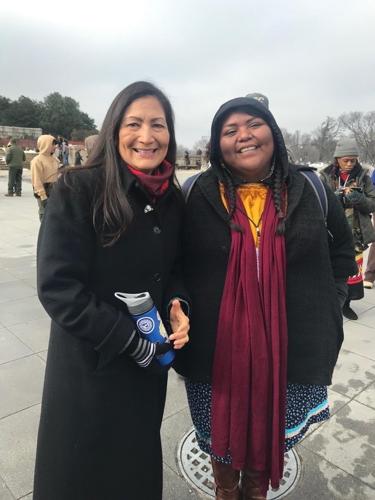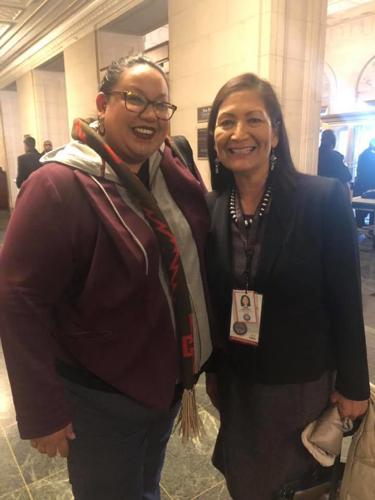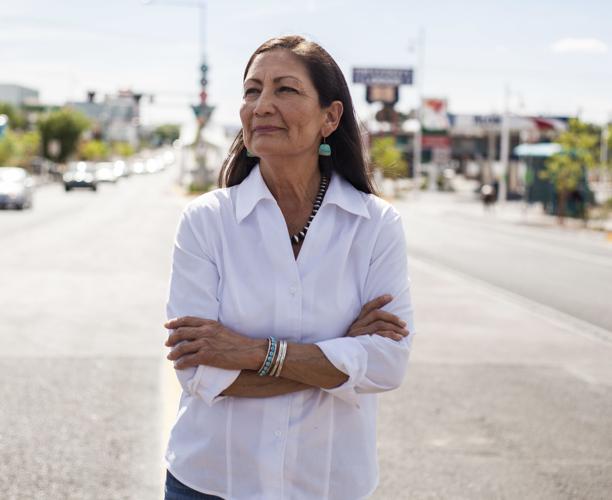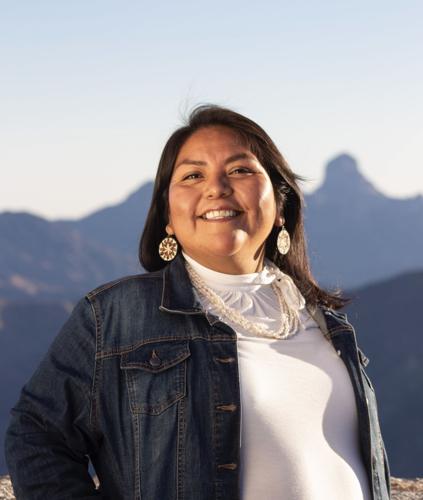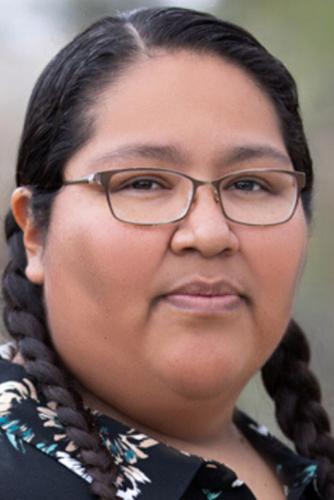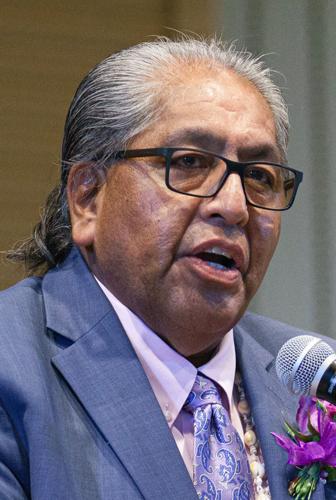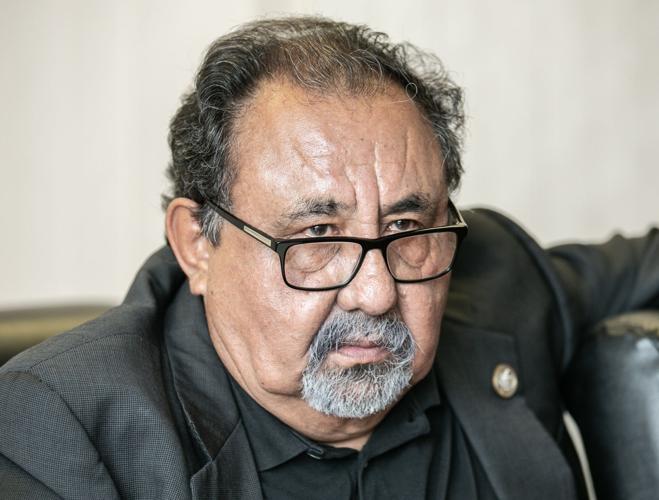Newly elected Pima County Recorder Gabriela Cazares-Kelly, the product of a U.S. Bureau of Indian Affairs education herself, is thrilled that fellow Native American U.S. Rep. Deb Haaland is a Senate confirmation away from becoming Interior secretary.
“We are the only group of people, Native Americans, that have a division of the government dedicated just to them. But we have never had a Native American in charge of this division,” said Cazares-Kelly, who attended a school run by the Bureau of Indian Affairs, which is part of the Interior Department.
Being named Interior secretary is “groundbreaking” for somebody like Haaland who has lived these experiences and who champions native issues such as land and education that are housed within Interior, Cazares-Kelly said Friday. She spoke a day after President-elect Joe Biden nominated the New Mexico Democrat to the post.
Groundbreaking. A historic day for Native Americans. A first real chance for tribes to have a voice in Washington. A seismic change.
Those are some reactions to Haaland’s nomination from Indigenous leaders and from activists to her being selected not only the first tribal interior secretary, but the first Native American to become a U.S. Cabinet secretary. Her nomination comes two years after Haaland became one of the first two Native American women elected to Congress.
“It’s a little bit more than inspiring. I think it’s that there’s a lot of Indian people who are supporting her and they believe in her. They trust her judgment because she’s a mom, because she is Native, because she has had a lot of similar experiences as other Natives in the U.S.,” said April Ignacio, an O’Odham who chairs the Arizona Democratic Party’s Native American caucus.
She and Cazares-Kelly are co-founders of Indivisible Tohono, a grassroots group that provides tribal members opportunities for civic education and works on issues affecting tribal members.
“She grew up without running water. She grew up without electricity. She knows what it’s like to be a champion for Native people,” Ignacio said of Haaland. “It’s also about representation. It’s about looking at this Cabinet that looks like America and it includes the original, the first people. For the very first time, we feel like we finally have a seat at the table.”
Haaland’s nomination is a “seismic change,” said Mary Jo Tippeconic Fox, a University of Arizona professor of American Indian studies.
“The nomination of Rep. Deborah Haaland is historic, and even more significant because she is a woman (doubly invisible in an already invisible population),” Fox wrote in an email to the Star. “The possibility of having a Native American woman at the presidential Cabinet level with the opportunity to speak and act from a Native perspective on behalf of a population that is largely invisible to the federal government and mainstream society is sensational.
“Native Nations are hopeful that Rep. Haaland’s appointment will improve tribal consultation and have a transformative impact on the way the Department of the Interior handles Indian affairs,” Fox said.
Haaland will bring a unique and long overdue perspective to the department, “as well as a fierce determination to protect our environment and the rights of Indigenous people,” Tohono O’Odham Nation Chairman Ned Norris Jr. said in a news release. “The Nation urges the Senate to quickly hold hearings and approve her nomination so she can get to work right away.”
Young Native Americans can look up to Haaland and see her as a role model, said Aresta Tsosie-Paddock, an assistant professor at the University of Arizona’s Department of American Indian studies and in the Linguistics Department.
“I’m very elated and excited for this new appointment. When I read that she was picked there’s a lot of emotions attached to it,” Tsosie-Paddock said. “She’s going to be the steward of lands and also of Native issues. Knowing that she understands the philosophy of land and its connection to people, and her being raised in that matter, that speaks volumes.
“She’s a win-win for everyone. Not just Indigenous people, but those of us who have a relationship with Mother Earth or with the earth in that capacity,” Tsosie-Paddock added.
As U.S. Rep. Raúl Grijalva sees it, Haaland’s interior secretary nomination takes U.S. history full circle.
“You have a Department of Interior created primarily as we went west, but also created to disenfranchise the tribes across this country, across the land and cultures themselves, from boarding schools on, and the legacy of that,” Grijalva, who is the House Natural Resources Committee chairman, told the Star Friday.
“And all of a sudden, in charge of this agency that was created to oppress Indigenous people, you have an Indigenous woman who happens to be an advocate — rightly a Native American in charge of it.
“To me, that’s icing on the cake,” said Grijalva, a Tucson Democrat who pushed for her nomination.
Potential for controversy
But Haaland’s nomination brings more than an uplifting story about Native American achievement and an apparent end to what tribal leaders see as a legacy of official neglect of their interests in Washington, D.C.
Her confirmation would return Interior to the unabashedly pro-environmental policies of former Interior secretary and former Arizona Gov. Bruce Babbitt — and then some. It will replace one set of controversies spurred by President Trump’s pro-extractive industry policies with another set.
During the Clinton administration from 1993 to 2001, Babbitt ushered in a wave of new national monuments and efforts at overhauling grazing and mining policies across the West that triggered major opposition.
Haaland is a close Grijalva ally in Congress and serves as vice-chair of his committee.
As secretary, she would likely reverse the Trump administration’s decidedly pro-business public-lands policies.
The administration has dramatically scaled back previously created national monuments such as Bears Ears and Escalante-Grand Staircase in southern Utah, limited the reach of the Endangered Species Act and put the screws to enforcement of the Migratory Bird Treaty Act, among many other things.
Haaland’s congressional website contains recent news releases advocating ocean conservation; blasting what she says is Interior’s failure to meet a legal deadline to name lands to be conserved under recent federal legislation boosting the Land and Water Conservation Fund; and supporting expansion of clean energy infrastructure. She is a co-sponsor of Green New Deal legislation.
Grijalva told NBC News last week that while he hopes Republican senators will give Haaland a chance during the confirmation process, he sees the potential for opposition.
“The fact that she’s not coming in with Zinke’s or Bernhardt’s agendas, that she brings a whole different and more inclusive perspective into how that agency functions, I think that’s going to be one area of opposition,” said Grijalva, referring to current Interior Secretary David Bernhardt and his predecessor Ryan Zinke.
With issues facing Interior such as Bears Ears, possible uranium mining near the Grand Canyon and proposed copper and nickel mining at the edge of the Boundary Waters wilderness area in Minnesota, “Yes, there is going to be controversy” with Haaland at the helm, Grijalva told the Star.
“But the fact remains that I think there is external public will outside of Congress to do something about climate change and the role land and water are going to have with this that will offset some of the controversy,” he said. “I believe that given something solid and well done, people can get behind the initiatives” Haaland is likely to propose, he said.
If she can get confirmed and gets full decision-making authority from Biden, Haaland could make a huge difference in Interior Department policy, said Randy Serraglio, a conservation advocate for the Tucson-based Center for Biological Diversity.
“The federal government has been playing cowboys and Indians with public lands for 150 years, and the cowboys have always won. It’s about time to change,” Serraglio said.
A life story that inspires
Debra Anne Haaland, who is 60, is a member of the Pueblo of Laguna that lies just west of Albuquerque. She calls herself a 35th generation resident of New Mexico.
Born in Winslow and daughter of a 30-year combat Marine father and a Navy veteran mother, she has a life story that has drawn many to her side.
She attended 13 different public schools while growing up because her family moved around the country during her late father’s military service. He received a Silver Star for his service in the Vietnam War.
Haaland raised a daughter as a single mother who “has lived paycheck to paycheck” and at times relied on food stamps to support them, says the official biography on her congressional website.
She earned two University of New Mexico degrees, including one from its law school. She and her daughter, also a UNM graduate, continue to pay off student loans, her biography says.
She used to run a small business for several years producing and canning what she calls “Pueblo Salsa.” She later became the first female chair of the Laguna Development Corporation board of directors, in which she oversaw operations of a major tribal gaming enterprise.
She was also a tribal administrator for nearly three years during the 2010s for the San Felipe Pueblo in northern New Mexico. She also ran a local social service agency that helped people with developmental disabilities.
In Congress, Haaland has sponsored or co-sponsored numerous bills to protect or enhance tribal rights and economic development.
Just Friday, she blasted Trump on Twitter for “gutting” the Endangered Species Act before leaving office, in reaction to his having just adopted a new rule that could shrink the size of critical habitats that are federally established to prevent extinction of imperiled species.
On Thursday, after her nomination announcement, she tweeted, “Growing up in my mother’s Pueblo household has made me fierce. I’ll be fierce for all of us, our planet and all of our protected land.”
Activist stances concern ranchers
A discordant note about Haaland’s nomination came from Patrick Bray, a longtime Arizona cattle growers activist and now executive vice president of the Arizona Farm and Ranch Group, representing both industries.
Bray says he finds it sad that so much attention is being focused on Haaland and other Biden nominees’ ethnic backgrounds and skin colors instead of their qualifications.
“Whether she’s Native American or not doesn’t bother me. The question is, does she have the qualifications to run a major agency?”
Her activist stances concern Bray.
“We need to know that she’s going to work with those permittees that have to live and work out there and produce a product in this economy,” Bray said of ranchers whose cattle graze public lands. “If she can see that side, great. If she’s unable to, that’s going to be problematic.”
Grijalva said Haaland is well qualified for the secretary’s job.
“I have seen firsthand the passion and dedication she puts into these issues that are at the forefront of the Interior Department,” he said. “She understands that climate and environmental policy are really about all of us — the people of this country and this planet —ending environmental and economic exploitation in all its forms and building a more sustainable and more inclusive economy.”
Thrilled to meet “Auntie Deb”
To Cazares-Kelly and Ignacio in Southern Arizona, Haaland is “Auntie Deb.”
“It’s a term of endearment. It’s an acknowledgment of like, someone older, like a social courtesy, acknowledging that she’s the older, like she knows more,” said Ignacio, of Sells. “It’s just in our own culture of how we have a way for us to be connected. It’s just what we do. It is a respect thing.”
Ignacio met Haaland shortly after the New Mexican took her congressional seat, at a lobbying training with the Sierra Club in Washington, D.C., she recalled.
“She was coming out of the elevator; I saw her and I screamed, ‘Auntie Deb,’” Ignacio recalled. “She stopped in her tracks and kind of looked around.
“Being able to see her in her element was very much an emotional experience for me. She stopped and I cried,” Ignacio said.
In July 2020, Ignacio introduced Haaland at an online Native American Democratic Caucus meeting, and told her how proud Indian Country is of her being in Congress.
“She was moved by that. Her eyes did water. She had tears in her eyes although she wasn’t sobbing,” Ignacio said.
Another O’Odham activist who met Haaland is Amy Juan, community programs coordinator and office manager for the International Indian Treaty Council, a national group that recently moved its headquarters to Tucson.
Juan met Haaland in January 2019, when they joined hundreds of others in the Indigenous Peoples March on the National Mall in Washington, D.C. Haaland was one of many speakers at the event, which also included prayers, dance and songs.
“Getting to speak and talk with her, I was really impressed with her presence and energy, especially with her being a big figure there. She was really humble and reminded me of one of my aunts,” Juan said Saturday.
“She smiled at everybody. She made time for everybody. Everybody rushed her when she came, but she was very open. She had a really good grace about her to really connect with everybody,” Juan recalled.
Cazares-Kelly and Ignacio recalled that during the 2016 protests at the Standing Rock Sioux Reservation in the Dakotas against construction of the Dakota Access Pipeline, Haaland attended and made green chile stew and tortillas at the protest site.
“Now she is a person who would be able to shape legislation and shape policy for the protection of sacred lands that are constantly under threat,” said Cazares-Kelly, noting in particular the Trump administration’s construction of the border wall on Tohono O’Odham land along the Arizona-Mexico border.
“They blasted sacred lands, they waived protections such as the Native American Graves and Repatriation act, the Clean Water Act and the Clean Air Act for the desecration of these sacred lands,” Cazares-Kelly said.
“Now you have someone in charge of that entire division who understands what it means to these communities, what sacred means without having to have an explanation of that.”
At Interior, she can make positive community connections with tribes, Cazares-Kelly added.
“We have never had that before. We have always been ‘the Indian problem.’”


